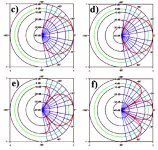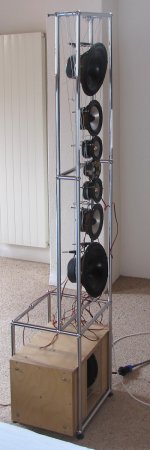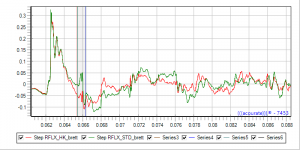Not rare, but not common. There are many DIY designs that hold some directivity down below 1kHzConstant directivity speakers - are they rare?
However since Toole's work was published, many think the "splash the walls" approach is the correct one. I don't however and will stay with my Unitys until I find something significantly better. I have another design I'm working on that might change my mind, but we'll see.
The Legacy Audio V's are an interesting design, but I'll have to read a lot on them to work out what the designer is doing. Ditto with the Kii Three's.
Not rare, but not common. There are many DIY designs that hold some directivity down below 1kHz
However since Toole's work was published, many think the "splash the walls" approach is the correct one. I don't however and will stay with my Unitys until I find something significantly better. I have another design I'm working on that might change my mind, but we'll see.
The Legacy Audio V's are an interesting design, but I'll have to read a lot on them to work out what the designer is doing. Ditto with the Kii Three's.
Splash the walls, but not too early. Don't splash the floor, ceiling, or front wall. It takes considerable directionality to prevent floor and ceiling splash... even more than most waveguides and unity horns provide. If you want your floor and ceiling reflections attenuated 10 dB or more, you need something like a 20 degree vertical beamwidth. If you make a horn or waveguide do that, you're probably getting a narrow horizontal beamwidth as well, or else you risk pattern flip with reasonable sizes and crossover points. That's not ideal.
For me, the ideal solution is a multi-way wall-mounted line array with careful cabinet design to reduce diffraction and use the front wall like an extended baffle.
However since Toole's work was published, many think the "splash the walls" approach is the correct one. I don't however and will stay with my Unitys until I find something significantly better.
Directivity index preference for analitical listening depends on hearing damage. The more hearing damage, the higher the preferred DI.
That is if I understand Toole correctly.
Utter bollocks.Directivity index preference for analitical listening depends on hearing damage. The more hearing damage, the higher the preferred DI.
That is if I understand Toole correctly.
Page number(s) please.
Last edited:
And then you have time of flight differences between the ends and centre of the line that makes them sound "phasey" to me. Never heard a long panel I liked, nor a line.For me, the ideal solution is a multi-way wall-mounted line array with careful cabinet design to reduce diffraction and use the front wall like an extended baffle.
And then you have time of flight differences between the ends and centre of the line that makes them sound "phasey" to me. Never heard a long panel I liked, nor a line.
A continuous infinite line doesn't have that, it has a cylindrical radiation pattern. To approach anything like that in practice you need very closely spaced small tweeters floor-to-ceiling.
My geometry disagrees with you in the real world.A continuous infinite line doesn't have that, it has a cylindrical radiation pattern. To approach anything like that in practice you need very closely spaced small tweeters floor-to-ceiling.
^listening/measuring distance plays a significant role with line arrays' vertical directivity effect. Simulations help to understand that eg. The Edge, you can move the virtual mic around in 3D. It is said that floor to ceiling version "mirrors" the length of the line, but in a small room there are multitude of other reflections too... Horizontal directivity is nothing special.
The directivity index (DI) magnitude plays an important role too. Toole prefers low but constannt DI while Geddes prefers high DI (with a horn). High DI gives longer distance where reflected energy wins over direct radiation (D/R ratio) The problem with high DI is that it is difficult to achieve below 500Hz and consistency is far from "constant"!
The directivity index (DI) magnitude plays an important role too. Toole prefers low but constannt DI while Geddes prefers high DI (with a horn). High DI gives longer distance where reflected energy wins over direct radiation (D/R ratio) The problem with high DI is that it is difficult to achieve below 500Hz and consistency is far from "constant"!
Last edited:
Splash the walls, but not too early. Don't splash the floor, ceiling, or front wall. It takes considerable directionality to prevent floor and ceiling splash... even more than most waveguides and unity horns provide. If you want your floor and ceiling reflections attenuated 10 dB or more, you need something like a 20 degree vertical beamwidth. If you make a horn or waveguide do that, you're probably getting a narrow horizontal beamwidth as well, or else you risk pattern flip with reasonable sizes and crossover points. That's not ideal. ...
Much more ideal then, and once again:
I'd go for a dipole setup along with Horbach-Keele xovers
http://www.xlrtechs.com/dbkeele.com/...20Part%202.pdf
You may e.g. define the target beamwidth = 51°, which corresponds to d/Lambda=0.77. This will provide a null heading vertically +-40°, or < -10dB intensity from 33° to 48°.
That's all you want to avoid floor and ceiling reflections.
The arguement for constant directivity as a generality......shouldn’t be.......some rooms benefit from narrow coverage either H or V....others don’t
All too often we ALL forget about the room....and in a DIY effort, this where DIY should excel as we can design/build to suit our intended environment.
Headphones do both....take the room out of the equation and offer constant directivity......do you find this enjoyable all the time?
Give me a small stand mounted 2 way bookshelf and some properly positioned subs in a big room any day of the week over all others. Some might make the arguement for high output systems.......but i wouldn’t pay much attention as this is the same group likely to have zero acuity above 10khz and like the sound of horn loaded compression drivers.
But if all else fails......modern DSP is capable of your goal with directional bass and carefully designed cancellation systems.......like Kii.......like Dipole.......without the size.
All too often we ALL forget about the room....and in a DIY effort, this where DIY should excel as we can design/build to suit our intended environment.
Headphones do both....take the room out of the equation and offer constant directivity......do you find this enjoyable all the time?
Give me a small stand mounted 2 way bookshelf and some properly positioned subs in a big room any day of the week over all others. Some might make the arguement for high output systems.......but i wouldn’t pay much attention as this is the same group likely to have zero acuity above 10khz and like the sound of horn loaded compression drivers.
But if all else fails......modern DSP is capable of your goal with directional bass and carefully designed cancellation systems.......like Kii.......like Dipole.......without the size.
Utter bollocks.
Page number(s) please.
I indeed remembered incorrectly.
It wasn't about DI but about the preferences of LCR balance. Page 353
We can argue though that DI preference could be related, but I won't.
I indeed remembered incorrectly.
It wasn't about DI but about the preferences of LCR balance. Page 353
We can argue though that DI preference could be related, but I won't.
Correction: I did remember correctly.
Page 445 last alinea.
Much more ideal then, and once again:
I'd go for a dipole setup along with Horbach-Keele xovers
http://www.xlrtechs.com/dbkeele.com/...20Part%202.pdf
You may e.g. define the target beamwidth = 51°, which corresponds to d/Lambda=0.77. This will provide a null heading vertically +-40°, or < -10dB intensity from 33° to 48°.
That's all you want to avoid floor and ceiling reflections.
Some additional explanations/illustrations to my previous post:
First picture shows how the vertical null can be set to virtually any angle within a Horbach-Keele array by adjusting the target beamwidth.
To check wheter this will behave as expected, I built a test setup with a Horbach-Keele array (2nd picture). A first measurement was made with the complete array driven as a regular HK array (ex w-boxed dipole woofer). Another measurement was made with only the tweeter and the 3 drivers of the bottom half of the array (ex w-boxed dipole woofer), this time driven by a LR4-xo (same xo-frequencies as in the HK-xo). So this latter measurement was mimicking a more or less standard LR4-setup.
Picture 3 shows the resulting impulse response. LR4 (green) shows a distinct floor reflection after some 3.2ms. Whereas HK (red) shows only a weak (tweeter) reflection at 3.2ms.
This is why I think that HK ist a nice approach to cancel floor and ceiling reflections. One could place the tweeter (symmetry point of the array) to a hight in order to provide a good compromise between floor an ceiling reflections rejection. And HK is intrinsically constant directivity in the vertical plane. So you get best of all worlds as a reward for a rather monstrous array.
Attachments
Not at all, but some of us live in the real world. If you live in HK, SF, NYC or even Sydney like me, the cost of moving to a larger premises is extreme in $, let alone other aspects of life such as travel that it's not practicable for many people. I live where I do for a variety of reasons and so am restricted to the room that I have. However, I own a house in the country where apart from the bedrooms and bathroom, the entire house is all one room and the best place to put the system (for living space, not just acoustics) means any reflections are well outside the Haas window. I don't have that luxury today.Something that is often ignored is that bigger rooms sound better so rather than spending a lot on upgrading your system at a certain point you should just move house. The larger the room (assuming one sweet spot) the less the directivity is going to matter.
Too true. I've seen system photos posted with such that have such poor set ups I laugh at some of the money they've spent on for example, expensive amps, when they'd get manifold improvements with a cheaper amp and better set up. Lower bragging rights on the lesser name brand amp though.... and how would you address the issues of dispersion for large panel ESL speakers? Or any dipole? It's like an alternate universe.
Some additional explanations/illustrations to my previous post:
First picture shows how the vertical null can be set to virtually any angle within a Horbach-Keele array by adjusting the target beamwidth.
To check wheter this will behave as expected, I built a test setup with a Horbach-Keele array (2nd picture). A first measurement was made with the complete array driven as a regular HK array (ex w-boxed dipole woofer). Another measurement was made with only the tweeter and the 3 drivers of the bottom half of the array (ex w-boxed dipole woofer), this time driven by a LR4-xo (same xo-frequencies as in the HK-xo). So this latter measurement was mimicking a more or less standard LR4-setup.
Picture 3 shows the resulting impulse response. LR4 (green) shows a distinct floor reflection after some 3.2ms. Whereas HK (red) shows only a weak (tweeter) reflection at 3.2ms.
This is why I think that HK ist a nice approach to cancel floor and ceiling reflections. One could place the tweeter (symmetry point of the array) to a hight in order to provide a good compromise between floor an ceiling reflections rejection. And HK is intrinsically constant directivity in the vertical plane. So you get best of all worlds as a reward for a rather monstrous array.
Trying to convince someone to do a four way WMMTMMW with FIR filters as a first project is, ummm, "challenging."
- Status
- This old topic is closed. If you want to reopen this topic, contact a moderator using the "Report Post" button.
- Home
- Loudspeakers
- Multi-Way
- Constant directivity speakers - are they rare?


